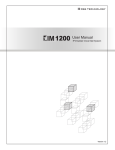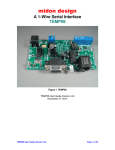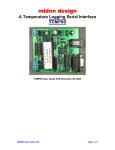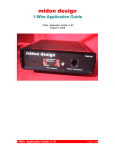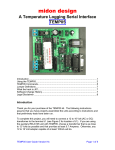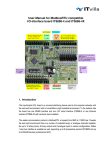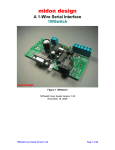Download LOG08-II User Guide Version 2.08
Transcript
midon design A 1-Wire Sensor Logging Device LOG08-II Figure 1 LOG08-II MD2134 July 30, 2011 LOG08-II User Guide Version 2.08 LOG08-II User Guide Version 2.08 Page 1 of 33 midon design 1. Table of Contents 1. Table of Contents................................................................................................2 1.1. List of Figures...............................................................................................3 1.2. List of Tables................................................................................................3 2. Revision History..................................................................................................4 3. Introduction.........................................................................................................5 3.1. 1-Wire Sensors Supported...........................................................................5 3.2. LOG08-II Features.......................................................................................5 3.3. Differences between LOG08-II and TEMP08/LOG08..................................6 4. Installation.........................................................................................................10 5. Using the LOG08-II...........................................................................................12 6. LOG08-II Commands........................................................................................14 6.1. Using the SET Command..........................................................................16 6.2. The DIS Display Output.............................................................................16 6.3. Using the LOG command...........................................................................18 6.4. DLO Output................................................................................................19 6.5. DLR Output................................................................................................21 6.6. Using the EEP, MEM and VIE Commands................................................21 6.7. TMP Output Display...................................................................................22 6.8. Setting the Clock........................................................................................23 7. Software Change History..................................................................................24 8. Trouble-Shooting Problems with LOG08-II.......................................................25 9. Error Messages.................................................................................................27 10. J4 Usage.........................................................................................................28 11. About the Battery............................................................................................30 12. LOG08-II Parts List.........................................................................................31 13. LOG08-II Schematic.......................................................................................32 14. Conclusion......................................................................................................33 14.1. Legal Disclaimer.......................................................................................33 LOG08-II User Guide Version 2.08 Page 2 of 33 midon design 1.1. List of Figures Figure 1 LOG08-II MD2134....................................................................................1 Figure 2 DS18S20/DS18B20/DS1822 Pin-out.....................................................10 Figure 3 LOG08-II Parts Placement.....................................................................11 Figure 4 Connector J4 RJ-12 Pin-out...................................................................28 Figure 5 LOG08-II Schematic...............................................................................32 1.2. List of Tables Table 1 Document Revision History.......................................................................4 Table 2 Midon 1-Wire Controller Properties...........................................................8 Table 3 LOG08-II Command List..........................................................................14 Table 4 Sensor Type Descriptions........................................................................18 Table 5 Sensors Supported by the LOG command..............................................19 Table 6 LOG08-II Software History.......................................................................24 Table 7 Common LOG08-II Problems and Resolutions.......................................25 Table 8 LOG08-II Error Messages........................................................................27 Table 9 Reset Type Messages.............................................................................27 Table 10 RJ-12 Pin-outs in use............................................................................28 Table 11 MD2135 Parts List.................................................................................31 Table 12 Additional Components for MD2136......................................................31 LOG08-II User Guide Version 2.08 Page 3 of 33 midon design 2. Revision History Table 1 Document Revision History Revision # 2.00 2.02 2.03 Date July 10, 2005 August 14, 2005 September 19, 2005 2.04 2.05 2.06 January 10, 2006 April 26, 2006 August 5, 2007 2.06 February 11, 2008 2.06d May 13, 2008 LOG08-II User Guide Version 2.08 Changes to User Manual Original Issue of document Updated to add ERF command Added details of voltage logging and introduced new option – DUN Added capability of logging DS2450’s Added VDD logging for DS2438 sensors. Added Vsense logging for DS2438 sensors. Added continuous logging capability. Updated the manual to provide clarity on usage of DS2438 sensors. Corrected error in schematic Page 4 of 33 midon design 3. Introduction LOG08-II is a stand-alone 1-Wire interface that provides the ability to record up to 3 years of readings from a variety of 1-Wire temperature sensors. The records are stored on LOG08-II until you require access to them. At any time in the recording process, you can download the records to your PC, via a standard RS232 serial interface. The records are conveniently output as comma separated entries and can easily be imported into Excel or other standard PC programs. 3.1. 1-Wire Sensors Supported • Multiple DS2438-based sensors, including, of course, the Midon Design MD3020E sensor. • Multiple DS18S20, DS18S20-PAR, DS18B20, DS1822, DS1920 temperature sensors as well as temperature reading from any DS2438 • • Multiple DS2423 general purpose counters (for use with Lightning sensors and other types of counter inputs) • Multiple DS2450 voltage sensors 3.2. LOG08-II Features • On-board voltage sensor with an option for an on-board humidity and/or temperature sensor. o The on-board voltage sensor is used to monitor the input voltage and the battery voltage. o Input voltage and battery voltage are automatically stored in the logging database • Jumper-less provisioning - all configuration settings stored in non-volatile memory • Up to 60 sensors supported for on-demand or timed polling • Up to 24 DS18S20, DS18B20, DS2438, or DS1822 temperature sensor results can be logged to non-volatile memory • Simple instruction set with a Help prompt for recalling command names LOG08-II User Guide Version 2.08 Page 5 of 33 midon design • Easy to delete sensors, if they are no longer required, using the DEL command • 1-Wire bus errors are flagged when they occur • Support for software serial flow control (Control-S, Control-Q) to permit inspection of long lists without scrolling beyond your terminal’s page length. Control-X can be used with the DLO and DLR commands to abort the display at any time. • Manual Poll of sensor readings. While LOG08-II is normally used for continuous (from 1 to 99 minute intervals) logging of sensor readings, it may also be used manually to take sensor readings on command from the serial interface. 3.3. Differences between LOG08-II and TEMP08/LOG08 LOG08-II is designed with many of the same principles as TEMP08 and LOG08 and uses similar hardware. Some new commands have been added to handle the logging functionality and some commands removed. LOG08-II also allows for logging of multiple sensors, unlike LOG08 which only logs 1 sensor at a time. UPGRADE NOTICE: Existing LOG08 devices cannot be upgraded via firmware change to LOG08-II. 1-Wire Wind Speed and Wind Direction sensors are not supported, although raw data from the DS2423 and the DS2450 devices used in such sensors is still available. 1-Wire rain bucket sensors are not supported, although raw data from the DS2423 devices used in such sensors is still available. Humidity sensors based on DS2438 devices are supported, however the output is “raw” and user calculations will be required to convert the voltage outputs provided to humidity levels using the following calculation: RH = ((VAD/Vsupply) - 0.16) / 0.0062 A hardware Real Time Clock (RTC) has been added to LOG08-II, along with an on-board battery to ensure clock continuity over a power failure. An on-board voltage monitor has been added to provide voltage readings for the input voltage and the battery for the RTC. A major difference between LOG08 and LOG08-II is the amount of memory space available. LOG08-II uses128Kbytes of EEPROM memory, whereas LOG08 only has 32K bytes of EEPROM memory. This provides for a significant LOG08-II User Guide Version 2.08 Page 6 of 33 midon design amount of additional storage capacity and LOG08-II, as a result, can store up to 3 months of log samples in its non-volatile memory for the maximum of 24 sensors. Here’s the math: 2 bytes per sensor sample required (note, DS2438’s require 2 samples and DS2450’s require 4 samples) 7 bytes of time stamp and on-board voltages per logging interval (poll) 24 sensors maximum polled per poll Total bytes per poll = 7 bytes/poll + 24 sensors/poll * 2 bytes/sensor = 55 bytes/poll 3 months at 1 poll per 60 minutes = 24 polls/day * 3 months * 30 days/month= 2,160 polls/3 months Total bytes used over 3 months = 55 bytes/poll * 2,160 polls/3 months = 118,800 bytes/3 months Of course, if fewer than 24 sensors are monitored, then the total logging time will be correspondingly higher. If only one sensor is logged, then the logs can be captured for up to 3 years. One sensor position of the sensor log database is always used for logging the on-board battery voltage and the power input voltage. 3.3.1. New LOG08-II commands DLR Display recent log samples SER Display serial number of LOG08-II SPR Enable or disable logging continuation following power-up 3.3.2. LOG08-II Commands not available with TEMP08 DLO DLR LOG SER SPR Display Log samples Display recent log samples Enable or disable logging Display serial number of LOG08-II Enable or disable logging continuation following power-up 3.3.3. TEMP08 Commands not implemented in LOG08-II RLT Set Relay Timer LOG08-II User Guide Version 2.08 Page 7 of 33 midon design RLY RLB ONA OFA WND WDR DEB Actuate Relay Actuate set of Relays Set switch Sensor on Set switch Sensor off Continuously Display wind direction Wind Direction Reverse Debug on/off The Relay commands, and related functions, were deleted since they did not make sense to be included with a logging device. Similarly, the switch sensor actuate commands were removed for the same reason. Wind direction, wind speed and rain counter functionality has been removed from LOG08-II to conserve program memory space. The DEB command has also been removed for the same reasons. Table 2 Midon 1-Wire Controller Properties Feature Up to 60 devices supported DS18S20, DS1822, DS18B20 Temperature sensors supported DS2423 counters supported DS2450 Voltage sensors supported DS2438 Voltage sensors supported DS2405 switch/input sensors supported DS2408 input/.output sensors supported 1-Wire Weather Station supported 1-Wire Rain gauge supported 1-Wire Humidity Sensor supported 1-Wire Relay sensor (Midon Design version) supported 1-Wire Barometric Pressure sensor (Bray/Jennings version) supported RELAY05 supported Log to memory supported Log multiple sensors to memory Logging memory available Real Time Clock Battery back up for Clock On board option for temperature sensor On board option for humidity sensor On board battery and supply voltage monitoring TEMP08 Y Y LOG08 Y Y LOG08-II Y Y Y Y Y Y Y Y Y Y Y Y Y Y N N N N N N Y Y Y N N Y(note) Y(note) Y(note) N Y N Y(note) Y N N 0 Y N Y Y N N Y N 32K Y N Y Y N N Y Y 128K Y Y Y Y(note) Y Note: DS2450 and DS2438 sensors noted above are logged or displayed only if the sensor type is set to “V”. It is the user’s responsibility to convert the raw sensor readings into the appropriate parameter required. DS2423 sensors noted LOG08-II User Guide Version 2.08 Page 8 of 33 midon design above are logged or displayed only if the sensor type is set to “C”. It is the user’s responsibility to convert the raw sensor readings into the appropriate parameter required. LOG08-II User Guide Version 2.08 Page 9 of 33 midon design 4. Installation Prior to use, insert the CR2032 battery into connector B1. It is shipped separately to avoid accidental discharge. To use this product, you will also need to connect a 12 to 20 Volt (AC or DC) transformer to the terminal J1 (see Figure 2 for location of J1). Any 12 to 20 Volt adapters capable of at least 100mA will do. Steady-state current consumption for LOG08-II is approximately 12mA. Note: Do NOT connect power to J3! Doing so will damage LOG08-II. If you are using a sensor network of 1-Wire devices, connect them now to connector J3 or J4. If you are using DS18S20, DS1822 or DS18B20, temperature sensors, only 2 pins of each device need to be connected, however a connection is required between the VDD and GND pins of the device if you are using parasitic power. If +5VDC local power is being used to power the sensor, connect the VDD terminal to it. See Figure 2 for device connections. Midon Design recommends that sensors are used in local powering mode to ensure the most reliable communication. Figure 2 DS18S20/DS18B20/DS1822 Pin-out LOG08-II User Guide Version 2.08 Page 10 of 33 midon design Figure 3 LOG08-II Parts Placement LOG08-II User Guide Version 2.08 Page 11 of 33 midon design 5. Using the LOG08-II Connect up a straight-through serial cable between LOG08-II's J2 connector and your PC. Open up HyperTerminal (or equivalent terminal emulator program) on your PC. Configure it to 9600 BPS, No parity, 8 bits, 1 start bit and NO hardware handshaking (very important!). Power up the LOG08-II and configure the unit for the devices that you have connected. The LED will initially flash red and then should change to a flashing green state. This is normal. The LED will change to flashing red whenever a 1-Wire sample is being taken. We recommend that you use the ERF command for first time use, to erase the EEPROM. This will remove any previous information that may have been stored in the EEPROM. Note: an ERF command will take considerable time (about 40 minutes) to execute due to the size of the memory being addressed. Next use the INI command to search for any 1-Wire devices connected to the 1Wire bus. If you get any error messages, it is most likely a result of a bad connection to the devices. Verify them. Typically, a "OW bus error" message indicates that a sensor has been installed in reverse, or that there is a short on the bus. Due to limited RAM space within LOG08-II, trying to INI more than 8 1-Wire sensors at a time may not always be possible. Should that cause problems, remove some sensors and re-do the INI function. Once all sensors have been identified on the 1-Wire bus, re-connect them and LOG08-II will establish communication to them without problem. Note: an ERA or ERF command is not required every time that an INI command is issued. It should only be required for first time use. Now program the configuration by using the SET command. Just type SET and the program will prompt you for the required settings; Polling interval, F/C display, serial ID display, power restore setting, and finally the real time clock setting. To verify that your setup is working properly, you should next use the TMP command to perform an immediate sensor reading. The output of the TMP command should look like the sample below (the exact output will depend on what type of sensors and how many you have installed). > LOG08-II User Guide Version 2.08 Page 12 of 33 midon design 12/18 20:24:12 Reading Sensors... Battery Voltage = 2.95V Input Voltage = 12.6V Humidity #01[CB0000003770C926]=52% Counter #01[BF00000004F3631D]=00256 Temp #01[060000003770D026]=75.22F Temp #02[440000001EC34228]=76.00F Temp #03[600008001E316D10]=77.67F Temp #04[F5000000375E9426]=74.77F Temp #05[CB0000003770C926]=74.77F Temp #06[91000800135B9B10]=75.35F Temp #07[21000000032E4E22]=75.45F > If there are no apparent errors, you are ready to use LOG08-II. Enjoy! LOG08-II User Guide Version 2.08 Page 13 of 33 midon design 6. LOG08-II Commands These commands are valid for all versions of LOG08-II software Table 3 LOG08-II Command List Command Description Syntax DEL Delete a sensor that was previously installed via the INI command DEL<sensorid> See Note 1 DIS Display serial numbers of all configured 1-Wire devices DIS DLO Display the log records. Output will be time-stamped and the entries separated by commas. DLO DLR Displays log records that are new since the last DLR or DLO command. The output is identical to the DLO command but records already displayed are suppressed. DLR DUN An option to enable (on) or disable (off) the display of units with the log file and poll output. DUN <on|off> EEP Display and change specific EEPROM memory locations EEP <start location><cr> ERA Erases just the serial numbers of sensors in the EEPROM. See also the ERF command. ERA ERF Erase the EEPROM (Note: due to the size of memory used, this will take considerable time – use with discretion) ERF HLP Display a list of available commands HLP INI Search for a list of available 1-Wire sensors. INI LOG Start or stop the logging process LOG <on|off> MEM Display and change specific memory locations MEM <start location><cr> RST Reset any DS2423 counter RST<sensorid> LOG08-II User Guide Version 2.08 Page 14 of 33 midon design Command Description Syntax SCK Set Clock SCK See Note 4 SER Display the serial number of the LOG08-II SER SET Configure all system parameters SET SID Show the Serial Number ID for the 1-Wire Devices SID <on|off> SPT Set the polling interval SPT xx Where xx is a decimal number from 00 to 99. 00 will disable polling and logging. Enter “R” instead of a number to enable repetitive polling (V2.06 and later) SPR Set power restore logging. If set to on, logging will resume after a power failure, if set to off, logging will not resume after a power failure. SPR <on|off> STD Set Temperature Display STD <F|C> TIM Display Time from Real Time Clock TIM TMP Display sensor readings of all connected 1-Wire Devices in either verbose (includes serial numbers) or non-verbose manner TMP TYP Select the type of DS2438 or DS2423 device. See Table 3 for valid types. TYP<sensorid> VER Displays the current version of the software loaded VER VIE A debug command that permits viewing the entire EEPROM log memory as Hexadecimal. VIE ZZZ Performs a reset of LOG08-II ZZZ Notes 1. The <sensorid> parameter in some commands above refers to the sensor number as shown via the DIS command. See the DIS command explanation below. 2. Most commands do not require a Carriage Return (enter) following the parameter or command input. One exception is the SCK command. Commands requiring a sensor number input will require a CR if the sensor number is only a single digit. LOG08-II User Guide Version 2.08 Page 15 of 33 midon design 3. Command parameters are shown in angled brackets “< >”. Where only certain options are permitted, they are indicated with a vertical pipe character “|”. 4. The SCK command will prompt the user for the time and date input. 6.1. Using the SET Command The SET command has multiple parameters. All parameters are also adjustable via discrete commands. All parameters established via the SET or discrete commands are retained in non-volatile memory. Update Interval This parameter determines the time between sensor readings, which is the same interval used to log samples. Set to 00 to stop polling and logging. Enter the time in decimal minutes or enter the letter R to enable Repetitive (continuous) polling. Use the SPT command to adjust only this parameter. F or C Display This parameter determines how temperature readings are displayed. Enter F for Fahrenheit or C for Celsius. Use the STD command to adjust only this parameter. Serial # Display Set this to On if you want LOG08-II to display the 1-wire ID of all sensors. Use the SID command to adjust only this parameter. Power Restore Set this to “on” if you want logging to continue following a power failure. Set to “off” if logging should stop following a power failure. Use the SPR command to adjust only this parameter. Set Clock Enter the current time here as Year, Day of week (01 = Sunday, 07 = Saturday), Month, Date, followed by Hour, Minutes, and lastly, Seconds. Use the SCK command to adjust the clock at any time, except when logging is set to On. 6.2. The DIS Display Output Sample DIS Output >dis LOG08-II User Guide Version 2.08 Page 16 of 33 midon design Serial # 0023 01 03 04 05 06 07 08 09 10 3000000002202920 440000001EC34228 600008001E316D10 F5000000375E9426 CB0000003770C926 91000800135B9B10 21000000032E4E22 590000000007B014 BF00000004F3631D DS2450 DS18B2 DS1820 DS2438 DS2438 DS1820 DS1822 DS2430 DS2423 OK OK OK OK T OK H OK OK OK OK C Update interval = 01 minutes [R] Temp display = F Serial # display = On Power Restore = On Logging = Off Samples = 00024 12/18 08:23:30 PM > 6.2.1. DIS output explanations The serial number displayed (in the example above: 0023) is set at the factory. Time is displayed as Month/Date Hours:Minutes:Seconds. Sensor numbers do not necessarily match up with the output from the regular sensor output readings. This is intentional. The sensor numbers in the DIS output are the memory locator and are used by the DEL, RST and TYP commands. The sensor numbers in the TMP output and regular polled output are sequential numbers for each type of sensor. An OK will be displayed following the sensor type to indicate that the Cyclic Redundancy Counter (CRC) checksum of the sensor's serial number is good. If the serial number has a bad CRC, an NG will be displayed. The checksum is validated during the output of the sensor display. Letters following the DS2423 and DS2438 indicate the TYPe of sensor equipped. This is a manual input and will be set following first discovery of the sensor via the INI command. The letters designate the sensor type per the following table. Use the TYP command to change a device type for DS2438’s. DS2423 sensors always default to type “C”. Note that the sensor type input for DS2438’s becomes irrelevant during a logging or polling cycle. All DS2438’s will default to type “V” during a logging session. LOG08-II User Guide Version 2.08 Page 17 of 33 midon design Table 4 Sensor Type Descriptions Designation Description OW Device C General Purpose Counter DS2423 H Humidity Sensor DS2438 T Temperature only from DS2438 DS2438 V Voltage Sensor DS2438 Following a display of the sensors installed, the output of the DIS display then shows the LOG08-II settings that you entered via the SET command. The Logging mode is then shown. Use the LOG command to enable or disable the logging mode. The quantity of stored samples is then displayed. Note: this capability is not present in software versions after 2.06. Following that display the DIS output proceeds to show how many temperature sensors are installed, by type. The DS18B2 type indicates a DS18B20 sensor. The DS1820 type is valid for DS1820, DS18S20 and DS1920 sensors. 6.3. Using the LOG command The LOG ON command will start recording of the samples from all connected temperature sensors, counts from DS2423’s, and also voltage readings from DS2438’s that may be connected. The clock cannot be changed following the issuance of the LOG ON command. The following commands are inhibited once logging is in process: DEL, EEP, ERA, ERF, INI, MEM, RST, SCK, SET, SID, SPT, STD, TYP. If LOG08-II is reset, via power failure or other means, the logging will be disabled if the Power Restore option is set to off. If the Power Restore option is set to on, then logging will resume after a power failure or other reset. The SPR command will change the Power Restore option. Use the LOG OFF command when finished logging. When the samples taken exceed available memory, the logging is automatically disabled and a “! Memory is full” message will be displayed. LOG08-II User Guide Version 2.08 Page 18 of 33 midon design The DLO command may be used at any time during the logging process to observe the entire contents of the log file. The DLR command may be used at any time to display logs received since the last DLR or DLO command. Logging will be done on the following 1-Wire sensors: Table 5 Sensors Supported by the LOG command Sensor DS1820 DS18S20 DS18B20 DS1822 DS2438 What is Logged Temperature Temperature Temperature Temperature Voltage from VAD and VDD and VSense Counter B – first 2 bytes only Voltages from A, B, C and D inputs DS2423 DS2450 6.4. DLO Output The DLO command is used to display the contents of the log records. A sample appears below. 6.4.1. DLO Display with DUN ON >DLO LOG08-II v2.06 2007-08-04 MidonDesign.com Serial # 0023 05 F5000000375E9426 DS2438 01 3000000002202920 DS2450 03 440000001EC34228 DS18B2 04 600008001E316D10 DS1820 07 91000800135B9B10 DS1820 08 21000000032E4E22 DS1822 OK OK OK OK OK OK 12/18,08:46:12 PM,2.96V,13.6V,05,2.09V,05,4.99V,05,0.31V,_ 01,2.38V,01,1.22V,01,4.75V,01,3.65V,_ 03,78.13F,04,82.30F,07,57.96F,08,78.11F 12/18,09:46:12 PM,2.96V,13.6V,05,2.09V,05,4.99V,05,0.31V,_ 01,2.38V,01,1.22V,01,4.75V,01,3.65V,_ 03,78.13F,04,82.30F,07,57.96F,08,78.11F 12/18,10:46:12 PM,2.96V,13.6V,05,2.09V,05,4.99V,05,0.31V,_ 01,2.38V,01,1.22V,01,4.75V,01,3.65V,_ 03,-127.99F,04,82.30F,07,57.96F,08,78.11F End of Log > LOG08-II User Guide Version 2.08 Page 19 of 33 midon design 6.4.2. DLO Display with DUN OFF >DLO LOG08-II v2.06 2007-08-04 MidonDesign.com Serial # 0023 05 F5000000375E9426 DS2438 01 3000000002202920 DS2450 03 440000001EC34228 DS18B2 04 600008001E316D10 DS1820 07 91000800135B9B10 DS1820 08 21000000032E4E22 DS1822 OK OK OK OK OK OK 12/18,08:46:12 PM,2.96,13.6,05,2.09,05,4.99,05,0.31,_ 01,2.38,01,1.22,01,4.75,01,3.65,_ 03,78.13,04,82.30,07,57.96,08,78.11 12/18,09:46:12 PM,2.96,13.6,05,2.09,05,4.99,05,0.31,_ 01,2.38,01,1.22,01,4.75,01,3.65,_ 03,78.13,04,82.30,07,57.96,08,78.11 12/18,10:46:12 PM,2.96,13.6,05,2.09,05,4.99,05,0.31,_ 01,2.38,01,1.22,01,4.75,01,3.65,_ 03,-127.99,04,82.30,07,57.96,08,78.11 End of Log > The output is straightforward. The display starts with the serial number of the LOG08-II device and then a list of all sensors being recorded. The sensor order may be different than the DIS display since the DLO display will display in the order that logging is done (DS2438’s first, DS2423’s next, DS2450’s next, all temperature sensors last). Each line starts with the date and time of the sample recorded. This is followed by a comma, then the on-board battery voltage, and then the power input voltage. Note: The Power Input voltage is calculated to approximate the actual input voltage. The presumed diode drop of the Full Wave Bridge U6 is added to the actual reading to provide the displayed voltage. This may lead to inaccuracies of the voltage reading and as a result the input voltage may vary by as much as ±1 volt from the actual input voltage. The voltage readings are followed by a comma, then the sensor number (from the DIS display) and then the actual sampled data for each sensor, separated by commas. The log record concludes with an End of Log indicator. Occasionally, errors will occur on the 1-Wire bus and temperature readings from one or more sensors will be invalid. These invalid readings will be displayed as -127.99F, or –127.99C, which is a reading that can never normally occur with any 1-Wire temperature sensor. LOG08-II User Guide Version 2.08 Page 20 of 33 midon design In the example shown, the Logging interval was set to 60 minutes. This can be set to any amount of time from 1 to 99 minutes. Some things to note: 1. If you have a DS2438 connected to your 1-Wire network and it is not set to TYPe V (voltage), this will be changed when you issue a LOG ON command to a V type. You can change this back after you have finished logging to another type if so desired, however, any other type set is really irrelevant. 2. If you have a DS2423 connected to your 1-Wire network and it is not set to TYPe C (counter), this will be changed when you issue a LOG ON command to a C type. 3. Temperature readings are not taken from DS2438 sensors at any time and will not appear in the logs as well. 6.5. DLR Output The DLR command output is identical to that of the DLO command with the sole difference being the amount of data shown. If the DLR is used for the first time following a LOG ON command, the display will be identical to the DLO output. Subsequent uses of the DLR command will display only information that is new since the last DLR or DLO command. If there is no new logged information, the End of Log message only will be displayed. 6.6. Using the EEP, MEM and VIE Commands These two commands provide direct access to the memory of LOG08-II and, as such, should be used with extreme caution. After entering the command, LOG08-II will display the contents of memory. Use the “;” key to advance to the next memory location, and use the “/” key to go to the previous memory location. Both commands will wrap around at the appropriate memory boundaries. To change a memory location using the MEM command, enter a hexadecimal value after the memory contents are displayed. Valid inputs are from “00” to “FF”. If the memory location is read-only, an “? Entry Error” error message will be displayed when you try to change the contents. To change a memory location using the EEP command, enter a hexadecimal value after the memory contents are displayed. Valid inputs are from “00” to “FF”. In both commands, a carriage return (enter) following display of the memory contents will terminate the command. LOG08-II User Guide Version 2.08 Page 21 of 33 midon design For a quick view of the entire EEPROM log memory, use the VIE command. It will output the contents in hexadecimal rows of 8 bytes each. To cancel the display at any time, use the Control-X key. To pause the output, use the ControlS key. To resume the display, use the Control-Q key. The commands noted in this section are not recommended for use without specific input from the manufacturer. 6.7. TMP Output Display The TMP output and polled output displays are identical. The TMP command simply triggers a poll that would normally occur at the next polling interval. An example is shown below. 6.7.1. TMP Output Display with DUN ON > 12/18 08:24:12 PM Reading Sensors... Battery Voltage = 2.95V Input Voltage = 12.6V Humidity #01[CB0000003770C926]=52% Voltage #01 [F5000000375E9426] = 1.24V 4.96V 0.31mV Counter #01[BF00000004F3631D]=00256 Temp #01[440000001EC34228]=76.00F Temp #02[600008001E316D10]=77.67F Temp #03[91000800135B9B10]=75.35F Temp #04[21000000032E4E22]=75.45F > 6.7.2. TMP Output Display with DUN OFF > 12/18 08:24:12 PM Reading Sensors... Battery Voltage = 2.95 Input Voltage = 12.6 Humidity #01[CB0000003770C926]=52 Voltage #01 [F5000000375E9426] = 1.24 4.96 0.31 Counter #01[BF00000004F3631D]=00256 Temp #01[440000001EC34228]=76.00 Temp #02[600008001E316D10]=77.67 Temp #03[91000800135B9B10]=75.35 Temp #04[21000000032E4E22]=75.45 > The output starts with a time reading. Next the battery and input voltages are displayed. These displays are followed by any humidity, voltage, counter, or LOG08-II User Guide Version 2.08 Page 22 of 33 midon design temperature readings depending on what 1-Wire sensors are connected to LOG08-II. The first voltage reading displayed for a DS2438 voltage sensor is always the external voltage from the DS2438 input. This is followed by the VDD voltage and then the Vsense input voltage. Changing a humidity type to a voltage type may be useful for trouble-shooting problems with a sensor. LOG08-II will communicate with each sensor during a TMP poll and will display the results as shown above. In the case of communication errors with any sensor, LOG08-II will re-try the communication up to 10 times. In the event that the communication still fails, then LOG08-II will display “???” instead of a valid sensor reading. The TMP command is disabled when logging is set to On. 6.8. Setting the Clock The SCK command is probably a bit too cryptic, so here is the meaning of the abbreviations used: >sck YR=07 (the Year) DY=04 (Day of the week – Sunday = 01, Monday = 02, etc.) MO=11 (Month) DT=21 (Date – the day of the month) HR=06 (Hour in 12 hour format) MI=36 (Minutes) SE=43 (Seconds) AM/PM= a (AM or PM – enter a or p only) >tim 11/21 06:36:45 AM > LOG08-II User Guide Version 2.08 Page 23 of 33 midon design 7. Software Change History Table 6 LOG08-II Software History Version Date 2.02 August 1, 2005 2.03 September 19, 2005 2.04 January 10, 2006 2.05 April 26, 2006 2.06 August 4, 2007 2.07 August 6, 2009 2.08 February 12, 2010 LOG08-II User Guide Version 2.08 Major Changes from Previous Loads Final production version of software Added the DUN option Added ability to log DS2450 sensors Added VDD logging for DS2438’s and fixed missing DS2423 sensor log issue. Added Vsense logging for DS2438 sensors. Added continuous logging capability. Added display for Humidity sensors during poll (this will not be logged however) Added more error checking for temperature sensors. Page 24 of 33 midon design 8. Trouble-Shooting Problems with LOG08-II The most common problems associated with using LOG08-II are listed in the following table. If these instructions do not result in better results with your LOG08-II, please feel free to contact Midon Design at [email protected]. We would be more than happy to assist you. Table 7 Common LOG08-II Problems and Resolutions Problem I cannot display LOG08-II output on my PC I cannot see what I type on Hyperterm I added a new sensor and now all I get is “OW Bus Error” messages I was able to add a new sensor but all I get is “???” readings from it. I removed a sensor from my wiring and now all I get is “???” readings from it. I added a DS2405 (or 2406 or 2407) sensor and I cannot see the state change when I change the input to it. I tried to add a bunch of sensors via the INI command and only some of them showed up. Possible Causes Ensure that you are connected with the proper settings (9600 bps, no parity) and that you are using a straight-through, not a null-modem, serial cable. This is normal for some Hyperterm versions that come pre-packaged with Windows. Upgrade to a commercial version of Hyperterm or use different terminal emulator software. Your sensor is probable reversed on the 1-Wire bus, OR, there is a short on the bus. Check your wiring. Check your 1-Wire bus wiring. You may also need to add a 100 Ω resistor in series with a new leg of bus that you added. Delete the sensor (use the DEL command). LOG08-II, unlike TEMP08, does not display state changes for these sensors. The algorithm used in the INI routine is limited in the number of new sensors that can be added due to small amount of RAM available to the LOG08-II. We recommend that you INI less than 8 sensors at a time. In rare cases, this number may need to be lower. The LED is not flashing Power to the LOG08-II may not be applied. Check your power supply. The DIS display shows a blank for “Temp The DUN option is set to Off. Set it to On. display = “ Humidity sensor output is not displayed Change the sensor type to “V”. DS2438 LOG08-II User Guide Version 2.08 Page 25 of 33 midon design Problem DS2438 temperature is not shown. LOG08-II User Guide Version 2.08 Possible Causes sensors will only display output if set to type “V”. Note: humidity display is available with versions 2.07 and greater. This is not supported on LOG08-II. Page 26 of 33 midon design 9. Error Messages Table 8 LOG08-II Error Messages Message Description ? Entry error You have made a syntax error in entering a command or a parameter You tried to add more than 60 1-wire devices via the INI command. LOG08-II has sufficient memory for only 60 unique 1-Wire device ID’s. ! Memory is full Not installed OW bus error Not Allowed – Logging = On Additionally, this error message will be issued when LOG08-II’s sample memory is full. There is sufficient memory for about 2,500 samples of up to 24 sensors per sample. LOG08-II could not communicate to the device that you were trying to access. Check your 1-Wire bus wiring. Common to any 1-wire bus read operation. This error indicates that something is preventing the bus from changing state. Typical causes include shorts on the bus, or a reversed sensor. Disconnect all sensors from J3 and J4 and try adding them one at a time to determine where the wiring error is. You are trying to use a command that is not permitted when logging is enabled. Disable logging first via the LOG OFF command. Table 9 Reset Type Messages Reset Type 02 04 08 10 20 40 80 Cause of Reset Low voltage – the power supply fell below spec Monitor Mode reset entry – should never be seen Illegal Address – something in the software caused access to an illegal address. Contact Midon Design Illegal Op Code reset – something in the code caused access to an invalid instruction. If this was not the result of a ZZZ command, contact Midon Design Watchdog timeout. The software was busied out with something. If this occurs too frequently, contact Midon Design User reset – you issued a ZZZ command Power on reset – a normal entry Binary combinations of the above reset types are also possible (the reset type number is in hexadecimal). For instance, a reset type of “50” is normal since the User Reset (40) is accomplished via the intentional use of an illegal op code (10). A power failure reset is usually also indicated via a type “82” reset. LOG08-II User Guide Version 2.08 Page 27 of 33 midon design 10. J4 Usage J4 is an RJ-12 connector, which is equivalent to a phone connector, except that it has 6 pins instead of just 4 (or 2). J5 is connected to the One Wire bus and can be used for adding connectivity to One Wire busses configured for RJ-11/12 connection. The pin-out of the J4 connector is shown in Figure 3. Figure 4 Connector J4 RJ-12 Pin-out Pin 1 is derived from the power supply feeding LOG08. It is DC rectified, so it will not matter if your power supply is AC only. Please note that this pin-out may be different than that of your 1-Wire sensors. Up until recently, there was no established standard pin-out for the RJ12 wiring and, as a result, different manufacturers have chosen to use the pins in various ways. The common pins (DQ and Ground) have remained the same for all manufacturers, however, as of the time of writing this manual. These pins are shown in color in the table below. Some of the published pin-outs available today are shown in the table below. Please take caution in connecting up your 1Wire sensor to LOG08 to avoid damaging the sensor. Table 10 RJ-12 Pin-outs in use Device Pin 1 Pin 2 Pin 3 Pin 4 Pin 5 Pin 6 +5VDC GND DQ GND N/C DC Supply Midon Design MD2004 TEMP05 N/C +5VDC DQ GND N/C N/C Midon Design MD2104 TEMP08 DC Supply +5VDC DQ GND N/C N/C Midon Design MD2124 LOG08 DC Supply +5VDC DQ GND N/C N/C Midon Design MD2135 LOG08-II DC Supply +5VDC DQ GND N/C N/C N/C +5VDC DQ GND N/C N/C DC Supply +5VDC DQ GND N/C N/C Dallas/Maxim wiring standard (published Oct 2001) Midon Design MD3009 Temp Sensor Midon Design MD3020 Temp and Humidity Sensor LOG08-II User Guide Version 2.08 Page 28 of 33 midon design Device Pin 1 Pin 2 Pin 3 Pin 4 Pin 5 Pin 6 DC Supply +5VDC DQ GND N/C N/C Simon Atkins’ Hub (shown for reference only. LOG08 does not currently support this device) +5VDC DC Supply DQ GND DC Supply GND AAG TAI8550 Combo Switch +5VDC GND DQ GND N/C N/C AAG TAI8520 Temp Sensor +5VDC GND DQ GND N/C N/C AAG V3 1-Wire Weather Station N/C +5VDC DQ GND GND N/C AAG TAI8540A Humidity Sensor N/C N/C (GND?) DQ GND N/C (+5VDC?) N/C AAG TAI8555 Latch Relay N/C GND DQ GND N/C N/C AAG TAI8585 Counter Kit N/C N/C DQ GND N/C N/C AAG DS9097U-S09-X N/C GND DQ GND +5V N/C Midon Design MD208x Relay and LED Sensor LOG08-II User Guide Version 2.08 Page 29 of 33 midon design 11. About the Battery The CR2032 Lithium battery included with your LOG08-II should last a long time, due to the low current consumption of the circuit that it powers. The “Battery Voltage” readings delivered by LOG08-II should show about 3.0 volts for this lifetime. As the voltage drifts down to 2.0 volts, consider changing the battery, which is a standard “watch” battery available nearly everywhere. Proper disposal of Lithium batteries should be observed. Please note that the battery supplies power to the real-time clock only. The rest of the LOG08-II circuit requires a power supply to function. If you are not using LOG08-II for any length of time, remove the battery to prevent it draining. LOG08-II User Guide Version 2.08 Page 30 of 33 midon design 12. LOG08-II Parts List Table 11 MD2135 Parts List Part ID B1 C1 C2, 4-7 C3, 10 C9 D1, 2 DS1 J1 J2 J3 J4 PCB R1 R3, 5 R4 U1 U2 U3 U4 U5 U6 U7-10 X1 Quantity 1 1 5 2 1 2 1 1 1 1 1 1 1 2 1 1 1 1 1 1 1 4 1 Description Coin Battery 3V CR2032 type Capacitor Electrolytic axial 25V 1000uFd Capacitor electrolytic axial 10uFd Capacitor ceramic 0.1uFd Capacitor electrolytic axial 16V 100 uFd 1N4148 Signal diode Bipolar LED Terminal Block, 5.08MM, 2 position, PCB Mount Connector, PCB Mount, DB-9 Terminal Block, 5.08MM, 3 position, PCB Mount Connector RJ-12 (6 wire) PCB Resistor 1/4W 5% 1.5K Resistor 1/4W 5% 10K Resistor 1/4W 5% 33K MAX232 RS232 Interface DS1302 Real Time Clock Motorola 68HC908KX8 Flash Microcontroller LM78L05 Voltage Regulator 5V Crystal Oscillator 9.8304 MHz Full Wave Bridge 1A 100PIV 4 pin DIP 24C256 256Kx8 Serial EEPROM 8DIP Crystal 32.768KHz Table 12 Additional Components for MD2136 Part ID C8 R2 U12 U13 Quantity 1 1 1 1 Description Capacitor ceramic 0.1uFd Resistor 1/4W 5% 100K HIH-3610 Humidity Sensor Maxim DS2438 Voltage Monitor 12.1. LOG08-II User Guide Version 2.08 Page 31 of 33 midon design 13. LOG08-II Schematic Figure 5 LOG08-II Schematic a. LOG08-II User Guide v2.08.doc Page 32 of 33 midon design 14. Conclusion Your comments are appreciated. If you would like to submit feature requests or product recommendations, please e-mail us for a quote. 14.1. Legal Disclaimer YOUR USE OF THIS PRODUCT IS AT YOUR OWN RISK. YOU ASSUME FULL RESPONSIBILITY AND RISK OF LOSS RESULTING FROM THE USE OF THIS PRODUCT. MIDON DESIGN WILL NOT BE LIABLE FOR ANY DIRECT, SPECIAL, INDIRECT, INCIDENTAL, CONSEQUENTIAL OR PUNITIVE DAMAGES OR ANY OTHER DAMAGES WHATSOEVER, WHETHER IN AN ACTION BASED UPON A STATUTE, CONTRACT, TORT (INCLUDING, WITHOUT LIMITATION NEGLIGENCE) OR OTHERWISE, RELATING TO THE USE OF THIS PRODUCT. 1-Wire is a trademark of Dallas Semiconductor/Maxim. Thank you! [email protected] © Copyright 2004-2011 Midon Design. All rights reserved. No part of this document may be reproduced, recorded, transmitted or distributed in any form or by any means without the written consent of Midon Design. End of Document LOG08-II User Guide v2.08.doc Page 33 of 33


































